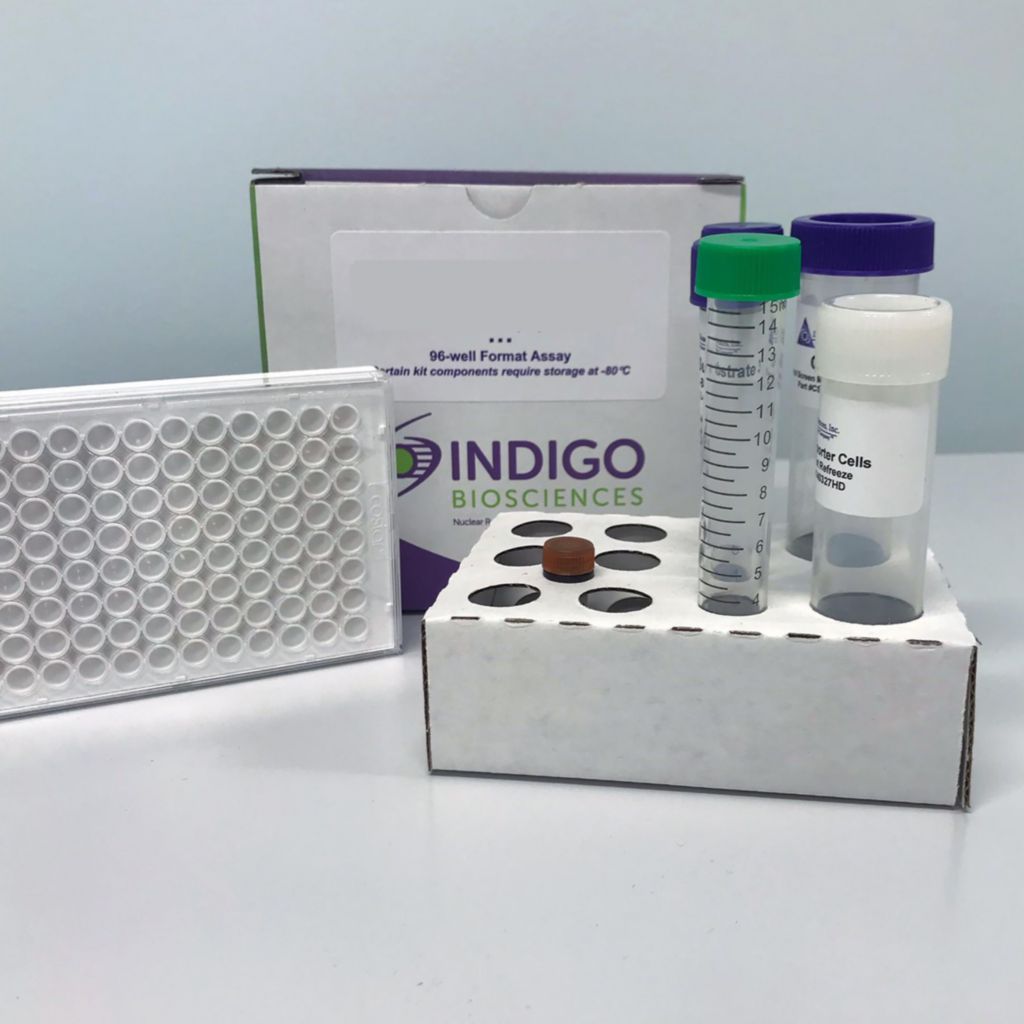Product Description and Product Data
This is an all-inclusive cell-based luciferase reporter assay kit targeting the Human Tropomyosin receptor kinases B (TrkB), which is also commonly referred to as Neurotrophic Tyrosine Kinase Receptor, type 2 (NTRK2). INDIGO’s TrkB reporter assay utilizes proprietary mammalian cells that have been engineered to provide constitutive expression of TrkB. In addition to TrkB Reporter Cells, this kit provides two optimized media for use during cell culture and in diluting the user’s test samples, a reference activator, Luciferase Detection Reagent, and a cell culture-ready assay plate. The principal application of this assay is in the screening of test samples to quantify any functional activity, either activating or inhibitory, that they may exert against human TrkB, or the coupled Ca+2∙calcineurin / NFAT signal transduction pathway. This kit provides researchers with clear, reproducible results, exceptional cell viability post-thaw, and consistent results lot to lot. Kits must be stored at -80C. Do not store in liquid nitrogen. Note: reporter cells cannot be refrozen or maintained in extended culture.
Features
Clear, Reproducible Results
- All-Inclusive Assay Systems
- Exceptional Cell Viability Post-Thaw
- Consistent Results Lot to Lot
Product Specifications
| Target Type | Growth Factor Receptor | ||
| Species | Human | ||
| Receptor Form | Native | ||
| Assay Mode | Agonist, Antagonist | ||
| Kit Components |
| ||
| Shelf Life | 6 months | ||
| Orthologs Available | No | ||
| Shipping Requirements | Dry Ice | ||
| Storage temperature | -80C |
Data
Target Background
Tropomyosin receptor kinases A, B and C constitute a family of receptors denoted as TrkA, TrkB, and TrkC. Trk’s are single-pass transmembrane receptors that contain an extracellular ligand-binding domain, transmembrane domain, and an intracellular tyrosine kinase domain. Neurotrophins, the physiological activators of Trk receptors, comprise a group of proteins that include Nerve Growth Factor beta (NGF-β), Neurotrophin 3 (NT-3), Neurotrophin 4 (NT-4) and Brain Derived-Neurotrophic Factor (BDNF). The active forms of these neurotrophins are disulfide-linked homodimer polypeptides. The binding of neurotrophins to Trk’s triggers receptor homodimerization and autophosphorylation. The intrinsic tyrosine kinase activities of activated, dimeric Trk receptor initiate intracellular signaling cascades that include RAS-MAPK, PI3-AKT, and PLCγ pathways. Trk’s are expressed in multiple tissue types, and are primarily involved in neuronal development, neuronal proliferation, and avoidance of programmed cell death. Chromosomal rearrangements of NTRK1-3 may result in gene fusions have been clinically validated as oncogenic drivers in a wide array of human cancers. TrkB receptors are the most prominently expressed Trk isotype in the brain, and bind BDNF and NT-4 with similar affinities. Recent studies have identified a direct link between reduced neurotrophin levels and development of cognitive illnesses like Alzheimer’s disease (AD). Not surprising, the Trk receptors command much interest as targets for drug development and drug safety screening. Indeed, small molecule neurotrophin mimics have shown promise as an emerging therapeutic for AD. In addition, the FDA has recently approved Trk inhibitors for the treatment of patients with solid tumors harboring NTRK gene fusions.
INDIGO’s TrkB Reporter Cells include the luciferase reporter gene functionally linked to tandem consensus sequences of NFAT genetic response elements upstream of a minimal promoter. Activated NFAT binds to these response elements to seed the formation of a complete transcription complex that drives Luc gene expression. Thus, quantifying changes in luciferase expression in the treated reporter cells provides a sensitive surrogate measure of the changes in human TrkB activity.
Therefore, the principal application of this reporter assay is in the screening of test compounds to quantify any functional activity that they may exert against TrkB, or the coupled Ca+2∙calcineurin / NFAT signal transduction pathway.
Product Documentation
Also available as a service

